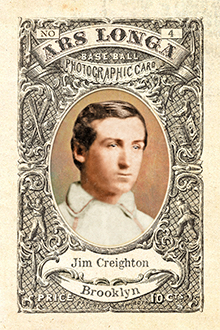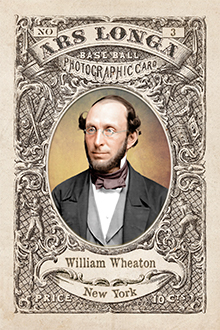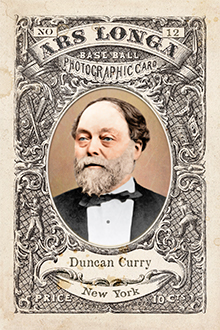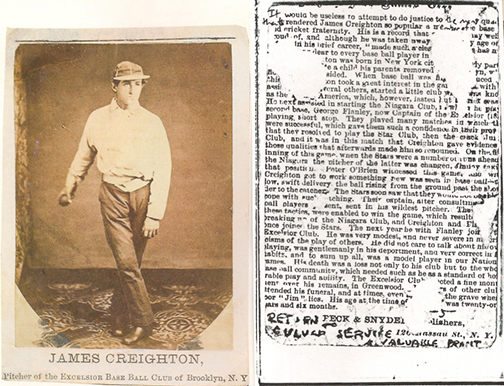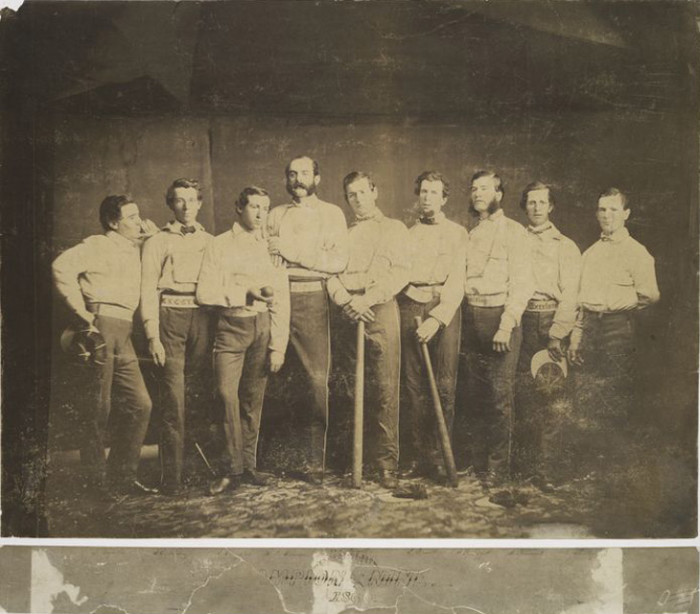John Thorn, in his book Baseball in the Garden of Eden, opens a section on Jim Creighton with the following anecdote:
In a cricket exhibition in 1859, Creighton played for an American 16 against an English 11, and clean bowled five wickets in six successive balls, an impressive performance for any level of competition. When John Lillywhite, one of England’s top players, witnessed Crieghton throwing a baseball, he honed in on the problem that American batters faced on the diamond: “Why, that man is not bowling, he is throwing underhand. It is the best disguised underhand throwing I ever saw, and might readily be taken for a fair delivery.
It’s a great story, at once illustrating the young Creighton’s rise as one of America’s top all-around athletes, and also addressing the controversy that immediately sprang up around his ability to do on the mound what no other pitcher could do.
Unfortunately, none of it tracks with what we can prove.
The fall of 1859 was a significant season in cricket. That was the year that the cream of the English crop made their first tour of North America, a dozen of the very best professionals. It was likely the greatest international sports event since the original Olympic game had last been held. The English team played five full international exhibitions, in each case sending their own picked 11 against 22 of the opposition, thereby giving their opponents twice as many batters in each inning. It didn’t matter; the English were embarrassingly easy victors in each match.
One of those series was held from Oct. 3-5 at the Elysian Fields in Hoboken, N.J., against a United States 22. But Creighton didn’t play in that series, much less take five wickets in rapid succession from the best players in the world. Nor was he one of the 10 Americans chosen to fill out two teams when the English stars finished their week in New Jersey by splitting their squad for a more competitive series.
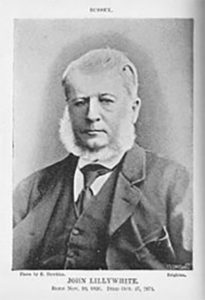
Lillywhite was indeed on that team of English internationals. His brother, Fred, was also along for the trip in a “traveling secretary” role. So significant was the tour that Fred Lillywhite published a book detailing the day-to-day events of the trip, The English Cricketers’ Trip to Canada and the United States in 1859, upon his return. There is no mention of Jim Creighton.
The problem with each half of the story is the source material. Creighton’s five-wicket performance comes from the 1891 New York Clipper Annual, a sports record book of sorts, in which the event is briefly chronicled in a section on great cricket bowling feats; it identifies the match as having taken place at Hoboken in 1860. The Lillywhite quote was found in a baseball column written by veteran sportswriter William Rankin . . . in an August 5, 1911 edition of the Clipper. In other words, 50 years or so after the fact, since Rankin puts the year at 1861. Considering that Rankin was 11 years old in 1860 and didn’t start his career as a sports writer for another decade, he’s clearly getting Lillywhite’s words second- or third-hand, most likely from the great Henry Chadwick himself.
More than likely, these events did happen in some way close to how they’re described. The best candidate for Creighton’s bowling performance was an 1861 match on October 1-2 between an English 11 and an American 22, in which Creighton registered five wickets on the first seven batters, although certainly not on six successive pitches. These “English” were not professional stars from across the pond, but likely British ex-pats who formed their own club in the New York area.
As for Lillywhite’s observations? Well, it’s easy to speculate. The English all-stars competed for six days in Hoboken that fall of 1859; isn’t it likely that an up-and-coming player like Creighton would attend at least a few of those days of competition? And might he have brought a baseball with him? And perhaps, might he have given a demonstration of his pitching skill on the sidelines, either to keep in shape for the Star Club’s big game the following week against the Atlantics, or maybe just to show off a little? And isn’t it possible that Lillywhite might have walked over to see what the fuss was about, and assessed the young hurler with a cricitcal eye?
Well, it’s possible, even plausible.
What’s the point, then, of putting these stories under this kind of microscope? Certainly not to disparage the scholarship of Thorn, one of our finest historians of baseball and 19th Century sports and culture, whose book, Baseball in the Garden of Eden, is must-reading for anyone interested in the origins of the game and the jingoistic motivations of some to cast those origins as being wholly American.
No, this is more a cautionary note about trying to get a clear picture of a man like Jim Creighton, with one foot in fact and the other in legend. There are sources for much of Creighton’s on-field accomplishments, and just as much that eludes solid verification. As for a true sense of his character, that remains tantalizingly out of reach . . .
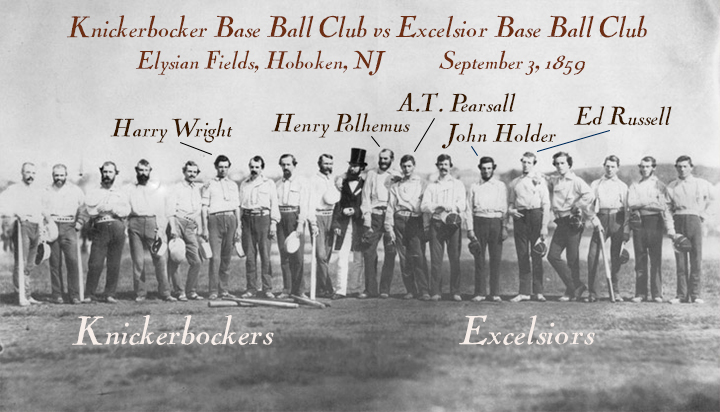
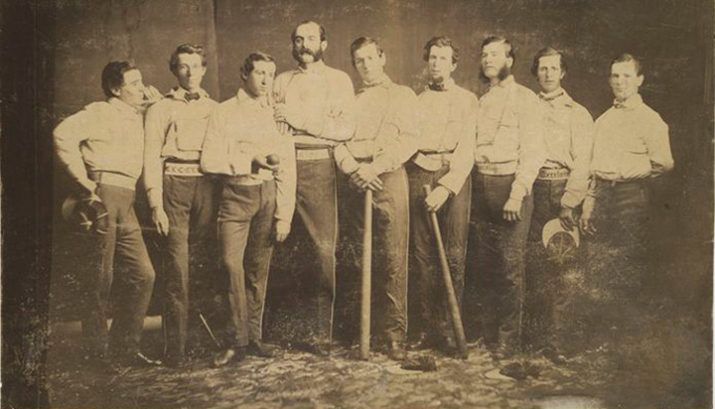
In the spring of 1860, the Excelsior Club of Brooklyn was poised to ascend to the pinnacle of the baseball world. Already recognized as one of a handful of top teams, it excelled both at bat and in the field, and with Creighton now in the fold it had a weapon that could intimidate most of its foes. It had one of the finest-fielding first basemen in the game in A.T. Pearsall, a massive, slugging outfielder in Henry Pohlhemus, and talented, hard-hitting young infielders in John Holder, John Whiting and Asa Brainard.

But mostly, what it had, was Joe Leggett.
You will often see Jim Creighton referred to as baseball’s first superstar, but not necessarily its best player. That title would likely have been bestowed on Leggett, the team’s 32-year-old catcher and captain. He was one of the Association’s leading hitters and the top catcher of the day. As the club’s de facto manager, he set the tone on and off the field, drilling his players hard in practice, orchestrating the Excelsior defense from behind the plate and requiring discipline and comportment as representatives of one of the game’s most respected clubs.
It was likely his partnership with Creighton that helped the young pitcher become the best in his position at the ripe old age of 19. Catchers of the day, working without any glove, had enough trouble handling the slower offerings of most pitchers, but Leggett embraced the challenge of catching an afternoon’s worth of Creighton’s faster pitches, all the while positioning himself close behind the batter and still being able to snag the foul tips that at that time counted as an out when caught on the fly or one bounce.
Leggett’s first act upon the club’s acquisition of Creighton was to send the pitcher home with a metal sphere the size of a baseball and have him spend the winter training with it, to build his arm strength and help him attain more “pop” in his pitches once using the regulation ball. After joining the Excelsiors, Creighton developed a “dew-drop” pitch, a slow, arcing delivery to throw batters off, as a change of pace to his usual fast, rising delivery. It’s impossible not to see Leggett’s hand in the development of that strategy.
Creighton had the talent and the skill, but Leggett had the savvy and leadership to help his young protege develop into something special, just what the Excelsiors needed to accomplish their ambitious plans for 1860.
Unfortunately, the next stage of Jim Creighton’s career couldn’t have gotten off to a worse start, either for himself or his club.
In 1859, the Excelsiors opened the season against a lesser Brooklyn Club, Charter Oak. The mid-May contest – early for an era in which the baseball season didn’t really get started until the summer months – likely was seen as a training exercise, a chance to get competition better than what could be found in an intrasquad game, yet not tough enough to actually result in a loss. Several of the club’s regulars weren’t even in the lineup.
And the Excelsiors lost, 18-17.
One would think that such an occurrence would have served as a lesson not to take any opposition lightly. And one would have been mistaken.
The Excelsiors again opened their season with a game against Charter Oak a month ahead of the rest of their schedule, on May 17, 1860, with all of its regulars in the lineup and their new pitcher on the mound. For Creighton, there must have been an eerie familiarity about the game. Charter Oak had made some improvements in its lineup with a number of new players from top youth teams. Two of Creighton’s Star Club teammates – the Patchen brothers, Sam and Joe – would be facing him. And the opposing pitcher? It was John Shields, the same pitcher whom Creighton relieved for the Niagaras the previous summer, in his breakout performance against the Star Club.
The Charter Oak lead-off man, a fellow named Vanderoef, opened the game with a triple, then stole home due to a miscommunication between Creighton and Leggett. Still, the Excelsiors led, 6-2, after an inning and appeared on their way to victory.
“The superior pitching of Mr. Crayton [sic] always calls forth the applause of all,” the correspondent for the Brooklyn Evening Star reported, “from the ease and force with which the ball leaves his hand.” Despite the ease and force, however, Mr. Creighton wasn’t necessarily fooling the Charter Oak batters, and didn’t get the expected support in the field. Charter Oak led, 8-6, after five innings, and although the Excelsiors twice tied the score in the later innings, a ninth-inning rally fell a run short in a 12-11 loss. Creighton, batting lead-off, didn’t help himself any by going hitless in five at-bats.
Sadly, the details of what was apparently a dramatic finish have been lost to time, due to the lack of access for the media in that pre-pressbox era. “We are obliged to confine our remarks on the play of the game and our reference to particular details almost entirely to the first innings,” the New York Clipper reported, “for afterwards the crowd encroached so much on the ground occupied by the scorers that we were unable to see the game, except by occasional glances.”
If the Excelsiors had a full month to stew over the loss until their next game, at least they had a chance for instant vengeance, as the opponent was again Charter Oak on June 21. After two innings, the Excelsiors led, 16-0, but the beneficiary of that outburst wasn’t Creighton, but Ed Russell, who had been the Excelsiors’ starting pitcher in 1859. Creighton did enter the game in the eighth and pitched two shutout innings of relief in a 36-9 victory, but this was hardly what had been expected of baseball’s pitching wunderkind.
Fortunately, a week later, Creighton faced a familiar foe that helped right himself, and just in time.
Brooklyn’s Star Club, Creighton’s team in 1859, had for several years carried the reputation of being the “crack” youth club of its day. But the thing about youths is that they grow up and join senior clubs. Many of the youth teams of the era simply folded when their core groups of players moved on. But the Star Club had greater aspirations, and became a full member of the National Association of Base Ball Players in the winter of 1859-60. Unfortunately, there was little talent left on the club that summer after defections to bigger clubs, and the Stars finished 0-5-1 against some fairly formidable competition.
Against his former club, Creighton was masterful, shutting out the Stars through six innings as the Excelsiors built a 14-0 lead through the top of the seventh. The Star Club was able to reach him for two in the seventh and three in the eighth, but there was little doubt that the young pitcher was hitting his stride with six strikeouts in the 16-5 victory, even with the distraction of the Great Eastern coming into view from the Excelsiors’ South Brooklyn field and creating a brief intermission as fans “oohed” and “ahhed” the visiting steam ship.
And his timing was good, as Creighton and the Excelsiors were on the verge of becoming known to a wider audience.
The concept of the road trip is nothing new. What cultivated young European man in the 18th Century would believe his education was complete before taking the Grand Tour of the continent?
But baseball in its early days was an enterprise that generally took place close to home. Travel was difficult and sometimes dangerous, even for short distances. Then there was the matter of getting protracted time off from one’s job; these were amateurs, after all, who had to work for a living.
But the Excelsiors moved to expand baseball’s horizons in 1860 with an unprecedented tour – of the rest of the state. Actually, the original plan was much more ambitious: Seven cities in New York, followed by trips to Boston, Providence and New Haven and then a jaunt down to Baltimore and Washington with a stop in Philadelphia on the way back. At one point, even an excursion to Detroit was considered.
Instead, the Excelsiors embarked on a pared-down-if-still-impressive six-game tour of New York state. On July 2, they defeated Champion of Albany, 24-6, following that up with a 13-7 victory the next day over Victory in nearby Troy. They moved on to Western New York, where they defeated Niagara of Buffalo, 50-19, on July 5, followed by victories over a pair of Rochester teams, 21-1 over Flour City on July 7 and 27-9 over Live Oak two days later. The tour ended with a 59-14 defeat of Hudson River in Newburgh on July 11.
Ten days, six games, all easy victories. The details of the games aren’t particularly important, as none of the opponents had any real expectations of pulling an upset. What was important was that the Excelsiors gave fledgling teams beyond baseball’s central point of the New York metropolitan area an idea of what was possible. The precision, the comportment on and off the field, the teamwork and the skills . . . these attributes were what were remarked upon in the local press when the Excelsiors came to town.
But Creighton was the revelation.
“The fielding of the Victorys was fully equal to that of the Excelsiors,” wrote the correspondent for the Troy Daily Whig of the July 3 game, “but the skillful pitching of the latter club, resulting in the balls flying in the air and being caught, had most telling effect.” The Buffalo Daily Courier singled out Creighton and first baseman Pearsall for the play in the field against the Niagaras.
But the most interesting item that appeared in print during the week may have been the lead to the Daily Whig‘s advance of the game against Victory. “The Excelsior Club of Brooklyn” its correspondent wrote, “who have pretty well reduced base ball to a science, and who pay their pitcher $500 a year, are making a crusade through the provinces . . .”
Whoa! Let’s hold up right there. This is pretty provocative territory. It’s a published item that has been offered by historians as a part of the proof that Creighton was a paid professional. What’s most interesting is that the reporter doesn’t seem to be making an accusation of cheating as much as an assessment that the Excelsiors were taking the sport to the next evolutionary level.
What doesn’t get cited by historians is a portion of the game story that appeared in the next day’s Daily Whig, after the Excelsiors jumped out to a 10-1 lead after three innings and cruised to a deceptively close six-run victory: “Their pitcher does not receive $500 a year, but he is a splendid player.”
That’s a rather stunning non-sequitur, completely assuming that the reader has seen the article of the day before. It suggests one of two things: that the correspondent had reported rumors that the Excelsiors vigorously squelched the next day, or that he had gotten the information from someone in the Excelsior party who had not expected to see his words staring him in the face the next morning from a newspaper page, with the club then needing to enter damage control on the day of the game.
None of this proves conclusively that Creighton was receiving a salary, just that the club had no desire to be seen as blatantly flaunting the rules.
Despite the relative lack of competition, the tour was still taxing on the Excelsiors. They played as many games in a week and a half as the average team played in a month and a half. As has been noted, travel at the time could be precarious. And then there was the aspect of being feted in each new city. Part of the club culture of baseball was to host visiting teams at sumptuous banquets, filled with endless toasts. With the Excelsiors traveling out of the Brooklyn/New York area for the first time, there was also a matter of tourism.
Consider how the club spent the Fourth of July: after arriving in Buffalo at 10 a.m. on the train from Albany, club members were a few hours later taken on an excursion to Niagara Falls, for a boat ride up the Niagara River, a performance by noted French tightrope walker Charles Blondin on a rope strung 160 feet above the gorge at the base of the Falls, some quick views of said Falls and then off to the Clifton House Hotel on the Canadian side for yet another banquet.

Its amazing the visitors from Brooklyn had anything left in their tank for the game the next day against the Niagara Club of Buffalo, unbeaten against Western New York competition. But the Excelsiors built a 44-6 lead through five innings before easing to victory. The box score of the game – courtesy of Mr. H.M. Gaylord, the Niagaras’ official scorer – was detailed enough to give some perspective on the amount of work a pitcher had to do in the days of no balls or called strikes, when a batter could simply wait for the pitch he wanted: Creighton finished with a pitch count of 244. And that was nothing compared to his opposite number, Franklin Sidway of the Niagaras, who clocked in at 354 pitches, including 115 in the 24-run Excelsior fifth inning. Certainly, the underhand delivery of the day didn’t take near as much out of the arm as today’s style, but still . . . Creighton did well at the plate, scoring six runs, but six of his teammates did just as well, including Leggett, who scored eight runs in nine at-bats, including a home run.
The Excelsiors’ game two days later in Rochester gets little attention in the grand scheme of the club’s season – the Flour City Club was hardly one of the Excelsiors’ toughest foes – but it deserves mention for one reason. Sifting through the evidence of the game’s box score, which finally made an appearance in the weekly New York Clipper three weeks after the game was played, Creighton recorded what may have been the most pristine pitching performance that had ever been seen. Flour City not only managed just a single run, but apparently had no more than four base runners and perhaps as few as three in nine innings. The only run allowed by Creighton was scored by a Mr. Avery as the leadoff batter in the second inning, but the box score allows for only one runner left on base, and a couple of putouts made at second base. Again, the level of competition wasn’t particularly high, but when you also factor in six strikeouts, you’d have to rank this as one of Creighton’s gems.
Back home in Brooklyn, there was little mention of the trip during the week in the daily newspapers, aside from the occasional bare scoreline. This wasn’t from a lack of interest as much as a limit on communications. Alexander Graham Bell was 13 years old and 16 years away from patenting the telephone. What little baseball news that got back to the big city was no doubt sent by telegraph.
But when the Excelsiors capped their tour in Newburgh, only 72 miles due north of Brooklyn, the rest of the baseball world caught up with them. Many fellow club members attended the game against Hudson River, as well as representatives of numerous other clubs.
The Clipper also sent a representative, most likely Chadwick, who gave the condition of the grounds a failing grade. This likely contributed to the ragged nature of the game, in which 73 runs were scored. Apparently, it wasn’t the pitcher’s fault. “It was Creighton’s pitching that told with such effect,” the Clipper reported, “the scores that were obtained [by Hudson River] . . . being the result of poor fielding . . .” Creighton also had a career day at the plate, scoring 10 runs without being put out once.
Creighton and his Excelsior teammates returned home on July 12 as conquering heroes, although the real triumph was not in the stature of the beaten foes as it was in expanding the club’s brand and showing other areas of the state, in which love of the sport was quickly growing, the level of sophistication that could be accomplished.
They also returned with sore fingers and hands from their 1,000-mile journey, not a good thing considering that in a week’s time they would take the field for the most important game of the year. Fatigue did not prove to be a problem, however, as Creighton was about to reach the apex of his standing in the baseball world.
Baseball championships, in the early days, were a subjective affair. Whether you were talking about city championships or national championships (which in Brooklyn was pretty much the same thing), there was initially no apparatus in place for determining a champion. There were no standings; teams played schedules that were wildly different in length and level of competition. But one thing was certain: any discussion of who was best, or who a team needed to beat to become the best, started with the Atlantics of Brooklyn.
The Atlantic Club formed in 1855, at a time when three New York clubs, the Knickerbockers, Gotham and Eagle, dominated the fledgling sport. Within two years, it had built itself into the team to beat, and with a 7-1-1 record, it was generally acclaimed the top team. The Atlantics were unbeaten in seven games in 1858, but didn’t play either the Mutuals or the Empires, a pair of one-loss teams.
It wasn’t until 1859 that the Association recognized a method for claiming a championship. That season, the Atlantics split a pair of games with their strongest Brooklyn rival, the Eckfords, then defeated the Eckfords in a rubber match, 22-12, on October 12. Two days later, the Atlantics defeated the Mutuals, 15-5, to cap a two-game sweep of the top New York contender. At 11-1, they had a record no other team could touch and were recognized as national champion. Plus, a precedent was set for determining a title.
Though a national champion would be recognized at the end of each season through 1870, the title was not won through a season-long portfolio of results but rather through head-to-head match play. The holders would accept a challenge to play a home-and-home series with another club; if the two teams split the games, a deciding game would be played on a neutral field, with the winner claiming the championship. The only other rule was that the series had to be completed within a single calendar year.
This was the ultimate aim of the Excelsiors in bringing a talent like Jim Creighton on board, to take the championship away from the Atlantics, and the two clubs had agreed to begin their series on July 19 at the Excelsiors’ Court Street grounds in South Brooklyn. The Excelsiors’ very recent successes in upstate New York had fueled what was already a great interest in the showdown, sparked by both the merits and the contrasts of the two teams.
There was a certain class distinction in baseball of the mid-19th Century, not particularly surprising when one considers that these were gentlemen’s club that engaged in social entertainment beyond just the baseball field. The Knickerbockers and their ilk, while fine-tuning the rules of the game, had been more about fellowship and exercise than heated competition. But in the wake of the forming of the National Association and the growing interest in the game as a spectator sport (and a vehicle for wagering), winning become more important.
The Excelsiors represented the new breed of “gentleman” clubs, their membership still largely from the white-collar world, but also determined to field the best team. The Atlantics were known as a “working man’s” club, with membership more likely to come from blue-collar pursuits. The crowds they drew had on occasion been known to get a bit out of hand.
But there was no question as to the quality of the Atlantics on the field. They featured some of the finest players of the day.
Leading the team were the O’Brien brothers, Peter and Mattie. Peter was a hard-hitting outfielder who was a mainstay of the club for nine seasons. His brother was one of the top pitchers of the day, and started on the mound for the Brooklyn team in the 1858 Fashion Course all-star series against New York. In Charley Smith, they had a clutch hitter and the man that Harry Wright himself proclaimed “the king of third basemen.” At shortstop was 24-year-old Dickey Pearce, an innovator both at bat – he gets credit, whether accurately or not, for developing the bunt as an offensive weapon – and in the field, and would play at the top levels of baseball for another 17 seasons.

Beyond having talent at every position, the Atlantics were the greatest team of their era in the clutch. Their late-inning rallies were legendary, often crushing a lesser team’s hopes just when that team thought it was going to spring an upset. Just a few weeks earlier, they had fallen behind the Putnam Club of Brooklyn, 10-8, heading into the eighth inning. But a couple of singles and a Putnam error cut the deficit to one run before Pearce slammed a ball down the leftfield line and circled the bases for a three-run home run, leading the way to a 14-11 Atlantics victory.
Of all teams, it was never more true than with the Atlantics that the game wasn’t over until the last man was out.
Is it any wonder that a crowd of more than 10,000, certainly the largest since the Fashion Course games two years earlier, descended on the Excelsior Club’s grounds on July 19?
It’s not easy to pinpoint the high point of an athletic career, even one as brief as that of Jim Creighton, but it’s hard to top this moment, shortly after 3 p.m. on an oppressively hot afternoon in South Brooklyn.
Creighton took the mound with a 2-0 lead – in 1860, it was the practice for the home team to bat first and cede the last-to-bat advantage to its guests – and faced Peter O’Brien, who fouled off a couple of pitches before striking out. Tice Hamilton followed with a high foul tip into the hands of Joe Leggett. Dickey Pearce watched several pitches before finding one he liked, which he popped up in foul territory to A.T. Pearsall at first base. Very quickly, Creighton had mowed down the top of the order of baseball’s reigning champion, setting the tone for the day.
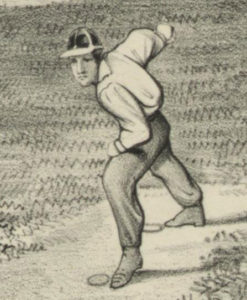
Creighton was nothing short of brilliant in the Excelsiors’ 23-4 victory, the worst loss ever experienced by the Atlantics. We have a clear picture of what happened that day because the New York Times published a full play-by-play, a distinct rarity back in the day, but one certainly warranted, given the importance of the game.
Creighton allowed only nine hits. Two of the four runs he allowed were unearned, owing to a bad day in the field by Excelsior third baseman John Whiting, who had three errors but made up for it by scoring five runs himself without being put out. Only Charlie Smith truly solved Creighton’s swift pitching, with four hits.
Only two Atlantic batters struck out, but nine were put out on foul tips to Leggett behind the plate. Creighton retired the side in order in the first, fourth and ninth innings, each time without a ball leaving the infield. In the seventh inning, after the Atlantics had scored twice and had runners on first and third with none out, Creighton induced Frank Seinsoth and O’Brien to tip out to Leggett, then got Hamilton on a bound out to Ed Russell in left field to end the threat.
And if that wasn’t enough, the young pitcher hit a thundering two-run triple in the fourth to give the Excelsiors a 12-1 lead.
It was about the most complete performance for which one could ask, performed on the biggest stage ever. “Creighton also placed himself at the head of the list as a ball player, especially as a pitcher,” the New York Clipper reported. The Times was more exuberant: “To Creighton, the pitcher, must be awarded the highest praise, his pitching being the theme of universal commendation both for its swiftness and regularity. He has well earned the reputation of the most effective pitcher in this region.” And therefore, the baseball world as a whole . . .
All things considered, the Atlantics took the shellacking fairly well. Oddly, their first-string pitcher, Mattie O’Brien, had started the game at third base, before relieving John Price in the fifth inning. But it made no difference; the Excelsiors hit both pitchers hard.
The newspapers lauded both teams for their sportsmanship, and praised the Excelsior management for keeping the peace with such a large crowd on hand. The Clipper correspondent (almost certainly Chadwick, the dean of 19th Century sportswriters) commented, “Above all we do select the gentlemanly conduct of the respective contestants throughout the match, and the prompt manner in which all outside comments were suppressed, as being worthy of the highest commendation . . . . We were also gratified in noticing that the decisions of the Umpire were promptly and silently acquiesced in, in every instance, and we trust this notable example will be followed on all like occasions.”
Sadly, Henry would soon have to eat those words.
Coming Soon:
Part 3: A bitter aftertaste to a heralded season.
Sources:
Baseball in the Garden of Eden by John Thorn
Jim Creighton by John Thorn (SABR bio project at sabr.org)
Inventing Baseball: The 100 Greatest Games of the Nineteenth Century, edited by Bill Felber of the SABR Nineteenth Century Committee
Baseball’s First Inning by William J. Ryczek
Baseball Founders by Craig B. Waff, William J. Ryczek and Peter Morris
The National Association of Baseball Players, 1857-70 by Marshall D. Wright
The English Cricketers’ Trip to Canada and the United States in 1859 by Fred Lillywhite
Digital editions of the New York Clipper, the New York Times, the Brooklyn Eagle, the Brooklyn Evening Star, the Troy Daily White and the Buffalo Daily Courier
